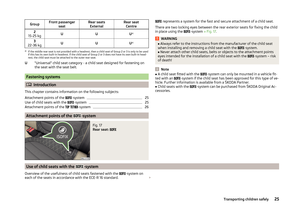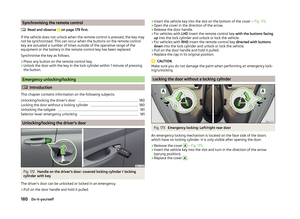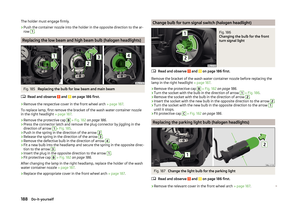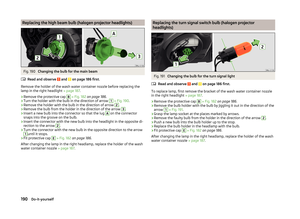Page 169 of 216
Wheel sizeDepth DTyre size5Jx1435 mm175/70 R146Jx1538 mm185/60 R15
Remove the full wheel trims before installing the snow chains » page 170.
WARNINGObserve the national legal regulations relating to the use of snow chains.
CAUTION
The chains are to be removed when driving where there is no snow. Otherwise
they cause loss of performance and damage the tyres.166General Maintenance
Page 170 of 216

Do-it-yourself
Emergency equipment, and self-help
Emergency equipment
Introduction
This chapter contains information on the following subjects:
Placement of the first aid kit and warning triangle
167
Placement of the reflective vest
167
Fire extinguisher
168
Vehicle tool kit
168
Placement of the first aid kit and warning triangle
Fig. 154
First aid kit and warning triangle
- Version 1
Fig. 155
First-aid kit and warning triangle - loosen version 2 / attachment
strap
The following information is for the first aid kit and warning triangle from the
ŠKODA Original accessories valid.
For another first aid kit and warning triangle the storage compartments may
possibly be too small.
First-aid box
The first-aid box can be attached by a strap to the right-hand side of the boot
» Fig. 154 or » Fig. 155 .
Warning triangle – version 1
The warning triangle can be stored in the rear wall trim panel » Fig. 154.
Warning triangle – version 2
The warning triangle can be placed in the panel at the right hand side of the
luggage compartment and secured to the fastening strap » Fig. 155.
Undo / secure fastening strap›
Press the latch on the connector in the direction of arrow
1
» Fig. 155 .
›
Release strap
A
in the direction of arrow
2
.
›
Pull strap
A
against arrow direction
2
until it locks into place.
WARNINGThe first-aid kit and warning triangle must always be secured safely so that
they do not come loose when making an emergency braking or in a vehicle
collision which could cause injuries to occupants.
Note
■ Pay attention to the expiration date of the first-aid kit.■We recommend using a first-aid box from ŠKODA Original Accessories availa-
ble from a ŠKODA Partner.
Placement of the reflective vest
Fig. 156
Storage compartment for the re-
flective vest
167Emergency equipment, and self-help
Page 171 of 216

The reflective vest can be stowed in the storage compartment inside the stor-
age compartment of the door A» Fig. 156 .
Fire extinguisher
Fig. 157
Fire extinguisher
The fire extinguisher is attached by two straps in a bracket under the front
passenger's seat.
Removing/attaching
›
Loosen the two straps by pulling the buckles in the direction of the arrow
» Fig. 157 .
›
Remove the fire extinguisher.
›
For mounting re-sit the fire extinguisher back into the holder and secure it
with straps.
Please read carefully the instructions which are attached to the fire extin-
guisher.
The fire extinguisher must be checked by an authorised person once a year.
National legal requirements must be observed.
WARNINGThe fire extinguisher must always be secured safely so that they do not
come loose when making an emergency braking or in a vehicle collision
which could cause injuries to occupants.
Note
■ The fire extinguisher must comply with national legal requirements.■Pay attention to the expiration date of the fire extinguisher. Proper function-
ing of the fire extinguisher is not assured once it has passed its expiry date.■
The fire extinguisher is part of the scope of delivery in certain countries only.
Vehicle tool kitFig. 158
Vehicle tool kit
The vehicle tool kit is housed in a box in the spare wheel or in the storage
space for the spare wheel.
Depending on the equipment, not all of the following components in the on-
board tool kit have to be contained in it.
Screwdriver
Adapter for anti-theft wheel bolts
Towing eye
Clamps for removing the wheel trims
Jack with sign
Wheel brace
Tool for removing wheel bolt caps
Replacement bulb set
Breakdown kit
WARNINGThe factory-supplied lifting jack is only intended for your model of vehicle.
Under no circumstances attempt to lift heavier vehicles or other loads. 123456789168Do-it-yourself
Page 172 of 216

CAUTION■Screw the jack back to the starting position before storing in the box with
the tool kit screws.■
Ensure that the vehicle tool kit is safely secured in the boot.
■
Ensure that the box is always secured with the strap.
Note
The declaration of conformity is included with the jack or the log folder.
Reserve and temporary spare wheel
Introduction
This chapter contains information on the following subjects:
Remove / store wheel
169
Spare wheel
169
When using an emergency or spare wheel make sure to mount a wheel with
the appropriate dimensions and design as soon as possible.
After changing the spare wheel, the tyre pressure should be adjusted. In vehi- cles with tyre pressure monitoring tyre pressure values are to be stored
» page 127 .
WARNING■
If, you get a puncture a spare tyre has to be mounted with a non-bound
direction or opposite direction of rotation when, then drive carefully. In this
situation the best properties of the tyre are no longer present.■
If the dimensions or design of the spare wheel differ from the tyres fitted
to the vehicle (e.g. winter tyres or low-profile tyres), it must only be used
briefly in the event of a puncture and if an appropriately cautious style of
driving is adopted.
■
If the dimensions or design of the temporary spare wheel differ from the
fitted tyres, never drive faster than 80 km/h (or 50 mph).
■
Never use the temporary spare wheel if it is damaged.
Remove / store wheelFig. 159
Taking the wheel out
Read and observe on page 169 first.
The wheel is located in a well under the floor covering in the boot and is fixed
in place with a special bolt » Fig. 159.
Taking the wheel out
›
Open the tailgate.
›
Lift up the floor in the luggage compartment.
›
Loosen the belt and take out the box with the tool kit.
›
Unscrew the nut in direction of arrow » Fig. 159.
›
Take out the wheel.
Stowing the wheel
›
Place the wheel into the spare wheel well with the wheel rim pointing down-
ward.
›
Pull the fixing band through the opposite holes in the wheel rim.
›
Screw on the nut in the opposite direction to the arrow » Fig. 159 until the
wheel is safely secured.
›
Replace the box with the tool kit into the spare wheel and secure it with the
tape.
›
Fold back the floor in the luggage compartment.
›
Close the tailgate.
Spare wheel
Read and observe
on page 169 first.
A yellow warning label is displayed on the rim of the temporary spare wheel.
169Emergency equipment, and self-help
Page 173 of 216

Please note the following if you intend to use the temporary spare wheel.› The warning label must not be covered after installing the wheel.
› Be specially attentive when driving.
› The temporary spare wheel is inflated to the maximum inflation pressure for
the vehicle » page 162.
› Only use the temporary spare wheel to reach the nearest specialist garage
since it is not intended for permanent use.WARNING■ Never drive with more than one spare wheel mounted!■Only use the spare wheel while absolutely necessary.■
Avoid accelerating at full throttle, sharp braking and fast cornering.
■
The snow chains cannot be used on the spare wheel.
■
Observe the instructions on the warning sign of the temporary spare
wheel.
Changing a wheel
Introduction
This chapter contains information on the following subjects:
Preparation
170
Full wheel trim
170
Wheel bolts
171
Changing a wheel
171
Subsequent steps
171
Loosening/tightening wheel bolts
172
Raising the vehicle
172
Anti-theft wheel bolts
173
For your own safety and the safety of the passengers, the following instruc-
tions must be observed before changing a wheel on the road.
Switch on the hazard lights.
The warning triangle must be set up at the prescribed distance - observe
the national legal provisions when doing so.
Park the vehicle as far away as possible from the flow of traffic.
Find a location with a flat, solid surface.
Have all the occupants get out. The passengers should not stand on the
road (instead they should remain behind a crash barrier, for instance) while
the wheel is being changed.
If the vehicle has been retrofitted with tyres which are different from those it
was fitted with at the works, follow these guidelines » page 164, Explanation
of the tire labelling .
The national legal requirements must be observed when changing a wheel.
Preparation
Before changing the wheel, the following work should be carried out.
›
Switch off the engine.
›
Engage the first gear or place the selector lever of the automatic transmis-
sion in the P-position.
›
Apply the handbrake firmly.
›
Uncouple any trailer.
›
Remove the vehicle tool kit » page 168 and the spare wheel » page 169 from
the boot.
Full wheel trim
Before removing the wheel bolts the wheel trim should be removed.
Pulling off
›
Hook the clamp found in the vehicle tool kit » page 168 into the reinforced
edge of the wheel trim.
›
Push the wheel wrench through the clamp, support on the tyre and pull off
the wheel trim.
Fitting
›
Press the wheel trim onto the wheel rim at the designated valve opening
» .
›
Then press the trim into the wheel rim until its entire circumference latches
correctly into position.
CAUTION
Notes from the factory or from the ŠKODA Original accessory delivered trim..■When using an anti-theft wheel bolt, make sure that this has been fitted ac-
cording to the position marked on the back of the wheel cover position.■
On the back of the wheel cover, the position for the anti-theft wheel bolt is
marked by means of a symbol. If the wheel cover is set outside the position
marked for the anti-theft wheel bolt, there is a risk of damaging the wheel
cover.
170Do-it-yourself
Page 174 of 216

CAUTION■Use the pressure of your hand only, do not strike the trim. The cover could be
damaged.■
If wheel trims are fitted, it must be ensured that an adequate flow of air is
assured to cool the brake system.
Note
We recommend that you use child seats from ŠKODA Original Accessories.
Wheel bolts
Fig. 160
Remove the cap
Before removing the wheel bolts the caps are to be removed.
Pulling off
›
Push the extraction pliers » page 168 sufficiently far onto the cap until the
inner catches of the pliers are positioned at the collar of the cap.
›
Remove the cap in the direction of the arrow » Fig. 160.
Fitting
›
Push the cap onto the wheel bolt up to the stop.
Changing a wheel
When changing a wheel, the following instructions must be followed.
›
Remove the full wheel trim or the caps of the wheel bolts.
›
First of all slacken the anti-theft wheel bolt and then the other wheel bolts.
›
Jack up the vehicle until the wheel that needs changing is clear of the
ground.
›
Unscrew the wheel bolts and place them on a clean surface (cloth, paper, etc.).
›
Remove the wheel carefully.
›
Attach the spare wheel and slightly screw on the wheel bolts.
› Lower the vehicle.›Tighten the opposite wheel bolts alternately (cross-wise) with the wheel
wrench. Tighten the anti-theft wheel bolt last.›
Replace the wheel trim or the caps.
When fitting unidirectional tyres, ensure that the direction of rotation is cor-
rect » page 164 .
WARNING■
Undo the wheel bolts only a little (about one turn) until the vehicle has
been jacked up. Otherwise the wheel could become loose and fall off.■
All bolts must be clean and must turn easily.
■
If it is established when changing a wheel that the wheel bolts are corro-
ded and difficult to move, then these must be replaced.
■
Under no circumstances grease or oil the wheel bolts!
Subsequent steps
After changing the wheel, the following work should be carried out.
›
Stow and attach the replaced wheel in the spare wheel well using a special
screw » page 169 , Reserve and temporary spare wheel .
›
Stow the tool kit in the space provided and secure using the strap.
›
Check the tyre pressure on the installed spare wheel as soon as possible.
›
Have the tightening torque of the wheel bolts checked with a torque
wrench as soon as possible.
After changing the wheel, the tyre pressure should be adjusted. In vehicles
with tyre pressure monitoring tyre pressure values are to be stored » page 127.
Change the damaged wheel or consult a specialist garage about repair possi-
bilities.
WARNINGInformation on the wheel bolts■The prescribed tightening torque of the wheel bolts for steel and light al-
loy wheels is 120 Nm.■
If the wheel bolts are tightened to a too low tightening torque, the rim
can come loose when the car is moving. A tightening torque which is too
high can damage the bolts and threads and this can result in permanent
deformation of the contact surfaces on the rim.
171Emergency equipment, and self-help
Page 175 of 216

WARNING (Continued)■In case of incorrect treatment of the wheel bolts, the wheel can loosen
when the car is moving.■
Drive cautiously and only at a moderate speed until the tightening torque
has been checked.
Loosening/tightening wheel bolts
Fig. 161
Changing a wheel: Loosening the
wheel bolts
Before removing the wheel bolts the caps from the wheel bolts must be re-
moved.
Undoing
›
Push the wheel wrench onto the wheel bolt as far as the stop 1)
.
›
Grasp the end of the wrench and turn the bolt about one turn in the direction
of the arrow » Fig. 161.
Tightening
›
Push the wheel wrench onto the wheel bolt as far as the stop 1)
.
›
Grasp the end of the wrench and turn the bolt against the direction of the
arrow » Fig. 161 until it is tight.
After tightening the wheel bolts the caps must be re-fit.
WARNINGIf it proves difficult to undo the bolts, carefully apply pressure to the end of
the wrench with your foot. Keep hold of the vehicle when doing so, and
make sure you keep your footing.Raising the vehicleFig. 162
Jacking points for positioning
lifting jack
Fig. 163
Attach lifting jack
To lift the vehicle, us the jack from the tool kit.
Position the car jack at the jacking point closest to the flat tyre.
The jacking points are located on the metal bar of the lower beam.
The positions of these are embossed by means of markings on the side sur-
face of the lower sill » Fig. 162.
›
Support the base plate of the jack with its full area resting on level ground
and ensure that the jack is located in a vertical position at the jacking point
» Fig. 163 -
.
›
Position the lifting jack below the jacking point with the crank and move it up
until its claw encloses the web » Fig. 163 -
.
›
Continue turning up the jack until the wheel is just about lifted off the
ground.
1)
Use the appropriate adapter for undoing and tightening the anti-theft wheel bolts
» page 173.
172Do-it-yourself
Page 176 of 216

WARNING■Choose a flat and firm surface for jacking the vehicle.■If the wheel has to be changed on a slope, first of all block the opposite
wheel with a stone or similar object to prevent the vehicle from unexpect-
edly rolling away.■
Secure the base plate of the lifting jack with suitable means to prevent
possible moving. A soft and slippery ground under the base plate may move
the lifting jack, causing the vehicle to fall down. It is therefore always nec-
essary to place the lifting jack on a solid surface or use a wide and stable
base. Use a non-slip base (e.g. a rubber foot mat) if the surface is smooth,
such as cobbled stones, tiled floor, etc.
■
Only attach the lifting jack to the attachment points provided for this pur-
pose.
■
Always raise the vehicle with the doors closed.
■
Never position any body parts, such as arms or legs under the vehicle,
while the vehicle is raised with a lifting jack.
■
When the vehicle is raised, never start the engine.
CAUTION
Make sure that the jack is attached correctly to the web on the lower sil, oth-
erwise there is a risk of damage to the vehicle.
Anti-theft wheel bolts
Fig. 164
Principle sketch: Anti-theft
wheel bolt with adapter
The anti-theft wheel bolts protect wheels from being stolen. These can only
be removed/tightened with the aid of the adapter
B
» Fig. 164 .
›
Remove the full wheel trim or the caps of the wheel bolts.
›
The adapter
B
» Fig. 164 with the toothed side all the way into the inner
teeth in the head of the anti-theft wheel bolts
A
stuck.
›
Push the wheel wrench onto the adapter
B
up to the stop.
› Loosen or tighten the wheel bolt
» page 172.›Remove the adapter.›
Replace the wheel trim or the caps.
For a possible wheel change the adapter for the anti-theft wheel bolts
should always be kept in the vehicle. The adapter is kept in the vehicle tool
kit.
Note
■ Note the embarked code number on both the adapter and at the end of each
anti-theft wheel bolt. This number can be used to purchase a ŠKODA Original
Parts replacement adapter, if necessary.■
The anti-theft wheel bolt set and adapter can be purchased from a ŠKODA
Partner.
■
The position of the anti-theft wheel bolt is marked on the back of the wheel
cover with every ŠKODA supplied original equipment hub cap or directly at the
factors. When using an anti-theft wheel bolt, make sure that this has been fit-
ted according to the position marked on the back of the wheel cover position.
Breakdown kit
Introduction
This chapter contains information on the following subjects:
Components of the puncture repair kit
174
General information
174
Preparations for using the breakdown kit
175
Sealing and inflating the tyre
175
Notes for driving with tyre repaired
175
Use the breakdown kit to reliably repair tyre damage caused by foreign bodies
or a puncture with diameters up to approx. 4 mm.
A repair made using the breakdown kit is never intended to replace a perma-
nent repair on the tyre. Its purpose is to get you to the nearest specialist ga-
rage.
The wheel need not be removed during the repair.
Do not remove foreign bodies , e.g. screws or nails, from the tyre.
173Emergency equipment, and self-help
 1
1 2
2 3
3 4
4 5
5 6
6 7
7 8
8 9
9 10
10 11
11 12
12 13
13 14
14 15
15 16
16 17
17 18
18 19
19 20
20 21
21 22
22 23
23 24
24 25
25 26
26 27
27 28
28 29
29 30
30 31
31 32
32 33
33 34
34 35
35 36
36 37
37 38
38 39
39 40
40 41
41 42
42 43
43 44
44 45
45 46
46 47
47 48
48 49
49 50
50 51
51 52
52 53
53 54
54 55
55 56
56 57
57 58
58 59
59 60
60 61
61 62
62 63
63 64
64 65
65 66
66 67
67 68
68 69
69 70
70 71
71 72
72 73
73 74
74 75
75 76
76 77
77 78
78 79
79 80
80 81
81 82
82 83
83 84
84 85
85 86
86 87
87 88
88 89
89 90
90 91
91 92
92 93
93 94
94 95
95 96
96 97
97 98
98 99
99 100
100 101
101 102
102 103
103 104
104 105
105 106
106 107
107 108
108 109
109 110
110 111
111 112
112 113
113 114
114 115
115 116
116 117
117 118
118 119
119 120
120 121
121 122
122 123
123 124
124 125
125 126
126 127
127 128
128 129
129 130
130 131
131 132
132 133
133 134
134 135
135 136
136 137
137 138
138 139
139 140
140 141
141 142
142 143
143 144
144 145
145 146
146 147
147 148
148 149
149 150
150 151
151 152
152 153
153 154
154 155
155 156
156 157
157 158
158 159
159 160
160 161
161 162
162 163
163 164
164 165
165 166
166 167
167 168
168 169
169 170
170 171
171 172
172 173
173 174
174 175
175 176
176 177
177 178
178 179
179 180
180 181
181 182
182 183
183 184
184 185
185 186
186 187
187 188
188 189
189 190
190 191
191 192
192 193
193 194
194 195
195 196
196 197
197 198
198 199
199 200
200 201
201 202
202 203
203 204
204 205
205 206
206 207
207 208
208 209
209 210
210 211
211 212
212 213
213 214
214 215
215






